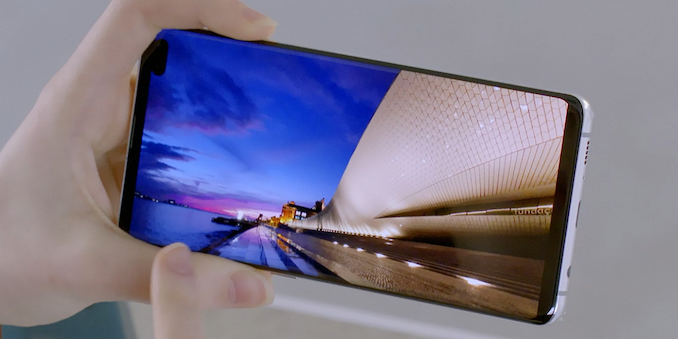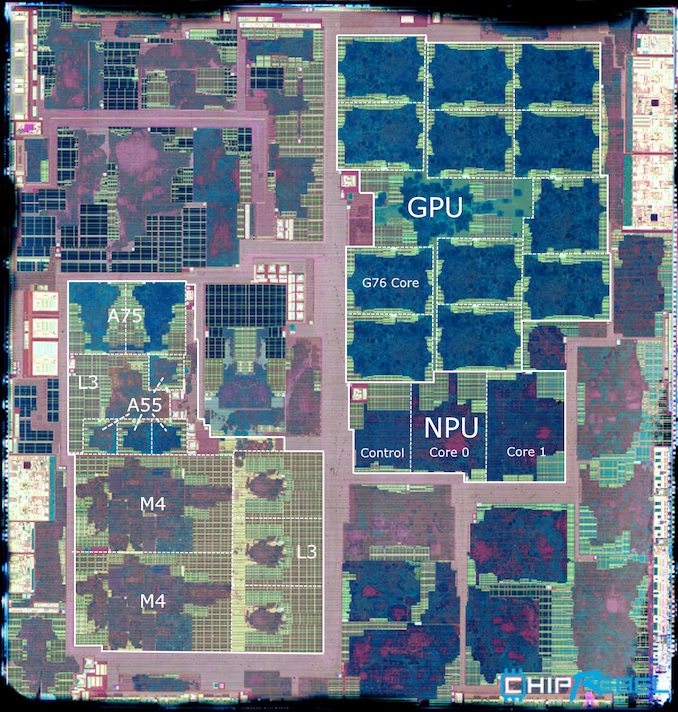ChipRebel Releases Exynos 9820 Die Shot: M4 CPUs in New Cluster
by Andrei Frumusanu on March 9, 2019 3:30 AM EST- Posted in
- Smartphones
- Samsung
- Mobile
- SoCs
- ChipRebel
- Exynos 9820

Every time a new SoC comes one, the one thing we eagerly await is for someone to release a die shot of the new chip. This process is most interesting when the new chip either comes with a new microarchitecture or a new process node. Last November, we covered the release of ChipRebel’s Kirin 980 die shot which gave us the first ever look of Arm’s new Cortex A76 CPU as well as Mali G76 GPU on a new 7nm process node.
The folks over there are at it again and have seemingly been very busy overnight, this time around tearing down the Galaxy S10 with the new Exynos 9820. I’ve been going back and forth with the ChipRebel team on these last two projects and they’re great guys, definitely visit them if you are in need of die shots.

Die shot: Chip Rebel - Annotations/labelling: Andrei @ AnandTech
8nm not as small as 7nm
The first thing standing out for the Exynos 9820 is the fact that at ~127mm², the chip has actually grown compared to the 10LPP Exynos 9810 of last year. Samsung’s 8LPP node isn’t as aggressive in scaling as TSMC’s 7nm process, and in theory the process node should bring a conservative 15% reduced area compared to its preceding node, leaving TSMC at a notable density advantage this generation. Compared to the Kirin 980 at 74.13mm², the Snapdragon 855 at 73.27mm² and even Apple’s A12 at 83.27mm², the new Exynos 9820 clearly stands out as out of line compared to the competition.
The Exynos 9820 also changes a lot internally, compared to the Exynos 9810 last year. First off we notice that the CPU cluster isn’t as prominent as it was last year. The reason for this is simply that Samsung opted to only employ two of its new generation M4 cores as opposed to the quad-core layout of the M3 in the 9810.
Interesting in the die shot is the new cluster layout: Next to the M4 cores we see now three L3 slices with a similar design as we saw in the 9810. However north of the two M4 cores we see a further L3 slice that differs from the other three. This slice seems to be the one that connects the new Cortex A55 and A75 cores to Samsung’s cluster.
I’ve had the Galaxy S10+ with the Exynos 9820 in-house since yesterday, and I can confirm that the L3 cache has remained at a total of 4MB, although I need a bit more time to figure out exactly how much of this is accessible by the Cortex cores as there’s power management policies coming into play.
The important thing to note here is that the Cortex A55 cores are no longer handicapped by not sharing the same higher level cache hierarchy as the rest of the CPU complex.
The new Exynos M4 cores clock up to 2.73GHz, the A75 cores at up to 2.31GHz and the A55 cores up to 1.95GHz.
On the GPU side of things, we still see Samsung dedicate a lot of area to the Mali G76MP12 – although it’s doesn’t look as big as last year’s G72MP18.
Finally, below the GPU, we find Samsung’s new NPU. This is a dual-core design running at up to 933MHz and offering up to 1.9TOPs at 8-bit precision, although Samsung looks to be counting 6.9TOPs in quantised models. Samsung themselves publish the die area of this block to be 5.5mm².
We thank the guys at ChipRebel for sharing this die shot with the public as it offers great analysis of Samsung’s new chip! On our side, we have the S10+ in-house now and I’ll be working on the full detailed device+SoC review.










66 Comments
View All Comments
mooremealymouthed - Saturday, March 9, 2019 - link
"Kirin 980 at 74.13mm², the Snapdragon 855 at 73.27mm² and even Apple’s A12 at 83.27mm²"I believe the Kirin and SD855 numbers also factor in the integrated LTE modem ? If yes, then shaving off another ~7mm2-10mm2 for modem from those Kirin/SD numbers brings their Apps area to ~64-66 for an apples to apples (sorry, couldn't help it) with the A12 .
Does that mean Kirin and SD are competing for feature parity with A12 with just 80% of A12's silicon ?
close - Monday, March 11, 2019 - link
It's possible, Apple's cores are usually pretty large. And the manual layout of the blocks is optimized for performance not density (or development cost and time, come to think of it). Or at least this was true in the previous ones, haven't looked that much into the recent SoCs.This did however bring significant performance advantages historically.
Santoval - Saturday, March 9, 2019 - link
Why are the M4 cores so huge? They are 3+ times as large as the A75 cores. While they are wider their slight speed edge over the A75 cores (at the same clock) does not justify such a large silicon area.I guess M4 cores must still be 2+ times larger than ARM's A76 cores, which are actually faster despite being more narrow. Apple went wider and gained speed at some efficiency loss, however as Samsung went wider they largely lost efficiency and needlessly blew up their silicon footprint. ARM is still the power efficiency king though, and starting with A76 it appears that their ambition is to compete in performance as well.
Raqia - Saturday, March 9, 2019 - link
From Andrei's tests, among the big cores Apple's have the best absolute performance and energy efficiency, however the absolute current draw combined w/ the smaller batteries they use lead to early degradation of those batteries and necessitates the formerly secret software throttling they've implemented. I think the A76 might be the most balanced design for a mobile form factor this generation.shadowx360 - Saturday, March 9, 2019 - link
That is a design choice though, Apple could throttle the A12s for lower absolute power usage and still easily beat any Android competitor. Qualcomm said last year basically "what single threaded disadvantage?" when questioned about their poor performance compared to the A11 but then tacitly acknowledged the issue by using a 1+3 design with a souped up A76. They're probably not stating the obvious that ARM designs smaller cores than the massive Apple ones because no one is vertically integrated like Apple so every middle man has to take a cut so we end up with cheaper, smaller cores given to OEMs. If ARM were to make A12 sized designs, the end price for OEMs would go through the roof after Qualcomm and ARM do their markups.Raqia - Saturday, March 9, 2019 - link
My point is that an A12 sized CPU design is suitable for tablets and laptops but not very compelling for phones due to the current draw and the lack of compelling use cases on phones for raw CPU ALU throughput. Apple doesn't have an integrated modem so they have the luxury of extra die space for their big CPUs as well along with a simpler layout and a cheaper process due to the different foundry feature requirements for fixed function analog signal processing units like the modem; an integrated modem isn't necessarily faster or more energy efficient but there are substantial cost savings to the end user in the cost savings from integration. The stellar single threaded CPU benchmarking numbers make for great marketing but the secret was that it only lasted for as long as your battery could handle the wear. (Any of Apple's recent environmental initiatives are also mainly a virtue signaling marketing gimmick whose actual environmental impact would have been outweighed by simply giving users the options to swap out a battery cheaply rather than forcing an upgrade.)shadowx360 - Sunday, March 10, 2019 - link
They're the only OEM that doesn't make it a Herculean task to try to swap out a battery. So while I agree they should make their batteries higher, there hasn't been that much excess battery wear compared to Android devices in reality, as their batteries are warrantied for holding 80% of charge at 2 years. Quite a few of my older Android devices started to shut down on me after a couple years.shadowx360 - Saturday, March 9, 2019 - link
If you are saying the A76 is faster based on the previous pre-dive article, the benchmarks provided showed system performance in more realistic benchmarks. Peak CPU performance even on the M3 cores was already higher than the A75s by a good amount (going by SpecInt/Geekbench), the issue was in the abysmal scheduler and DVFS response times. I predict the M4 cores will easily blow away the A76 in raw performance but once again the actual real life system performance will be hampered by scheduler or other quirks.GlossGhost - Sunday, March 10, 2019 - link
So it is, always. And I do not have my hopes high for this Samsung cUsToM brew but I want it to be good.kaspar737 - Sunday, March 10, 2019 - link
Why didn’t Samsung go with A76 instead of A75?